Gastropod diversity and evolution at the Paleozoic/Mesozoic transition
Section Fossil Molluscs
(DFG NU 96/6-1, 6-2; funded: 2002 bis 2005; Alexander von Humboldt Stiftung with Andrzej Kaim as fellow since 2009)
Gastropods comprise a vast number of species and have a good fossilization potential. Therefore, they represent and excellent object fort the study of paleo-diversity. This project is about the evolution and diversity of gastropods at the most profound Phanerozoic caesura: The Permian Triassic crisis. Aided by a database of all described Permian and Triassic gastropod species the evolution of one of the most important invertebrate groups is assessed and analyzed on the species and higher levels. To date, especially the Early Triassic disaster and recovery phase have been analyzed. At the same time, Early Triassic gastropod fauna have been studied and re-evaluated (Werfen Formation, South Alps; South China; Sinbad Limestone Member, Moenkopi Formation, Utah, U.S.A.). Extinction was rather severe in gastropods but they recover particularly fast. After an Early Triassic minimum of reported species, the number of species rises considerably as early as Smithian. It rises steeply in the Anisian and continues to rise until the Carnian when a peak of about 1000 nominate species was reached..
This rise is also reflected in the alpha-diversity of single faunas. Recovery is combined with a turnover, i.e. several groups appear for the first time in the Early Triassic and immediately form dominant faunal elements. For example Cylindrobullina convexa, the earliest certain opisthobranch, is one of the most abundant gastropods in the Early Triassic Sinbad Limestone (Utah).
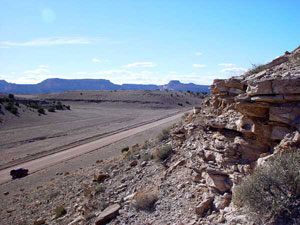
Sinbad Limestone (Moenkopi Formation), Utah, USA. From this outcrop the richest and best preserved Early Triassic (Smithian) gastropod fauna has been described by Batten & Stokes (1986). This fauna is re-evaluated in this project.. 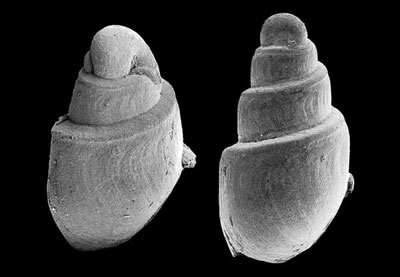
Cyllindrobullina convexa from Sinbad Limestone. This species represents the oldest certain opisthobranch.
It is one of the most common gastropods in the Sinbad Limestone. The material is excellently preserved and
the heterostrophic larval shell is well visible. From Nützel (2005).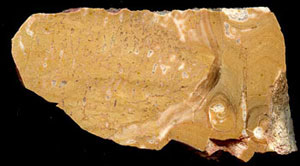
Stromatolites growing on gastropods (Sinbad Limestone). Early Triassic stromatolites are commonly interpreted as disaster phenomena. From Nützel & Schulbert (2005). 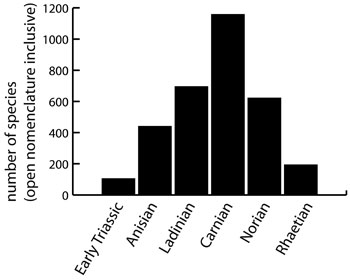
Diversity of gastropods throughout the Triassic. After a minimum in the Early Triassic, the number of species is steeply increasing until the Carnian which displays a peak of about 1000 species. From Nützel (2005). 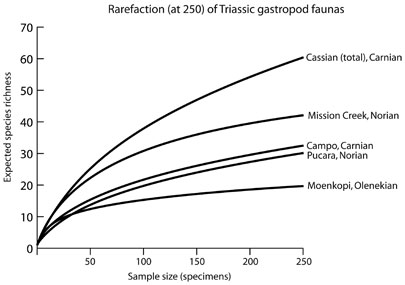
Rarefaction analysis of some of the richest Triassic gastropod faunas. Even the richest Early Triassic fauna (Sinbad Limestone, Moenkopi Formation) is clearly less diverse than the great Late Triassic gastropod faunas. From Nützel (2005).
Contact: Prof. Dr. Alexander Nützel
Cooperations
Douglas H. Erwin, Dept. of Paleobiology, Museum of Natural History, Smithsonian Institution, Washington D.C., U.S.A.
Pan Hua-zhang, Nanjing Institute of Geology and Palaeontology, Academia Sinica, Nanjing, People’s Republic of China
Michael Hautmann Institut für Paläontologie, Universität Würzburg
http://wwwalt.uni-wuerzburg.de/palaeontologie/staff/hautmann/
Hugo Bucher, Paläontologisches Institut und Museum Zürich
Publications
Hautmann, M. & Nützel, A. 2005. First record of a heterodont bivalve (Mollusca) from the Early Triassic: Implications for Scythian ecosystems and the `Lazarus problem´. Palaeontology 48: 1131-1138.
Nützel, A. & Pan Hua-zhang 2005. Late Paleozoic evolution of the Caenogastropoda: larval shell morphology and implications for the Permian/Triassic mass extinction event. Journal of Paleontology 79: 1175-1188.
Nützel, A. 2005. Recovery of gastropods in the Early Triassic. In Bottjer, D. and Gall J.-C. (eds) The biotic recovery from the end-Permian mass extinction. Comptes Rendus, Palevol 4: 501-515.
Nützel, A. & Schulbert, C. 2005. Facies of two important Early Triassic gastropod lagerstätten: implications for diversity patterns in the aftermath of the end-Permian mass extinction. Facies 51: 495-515.
Nützel, A. 2005. A new Early Triassic gastropod genus and the recovery of gastropods from the Permian/Triassic extinction. Acta Palaeontologica Polonica 50: 19-24.
Pan Hua-Zhang, D. H. Erwin, Nützel, A. & Zhu Xiang-shui 2003. Jiangxispira, a new Gastropod genus from the Early Triassic of China with Remarks on the Phylogeny of the Heterostropha at the Permian/Triassic Boundary. Journal of Paleontology 77: 44-49.
Nützel, A. & Erwin, D. H. 2002. Battenizyga, a new Early Triassic gastropod genus with a discussion of the caenogastropod evolution at the Permian/Triassic boundary. Paläontologische Zeitschrift 76: 21-27.

